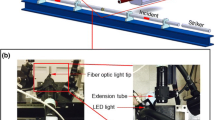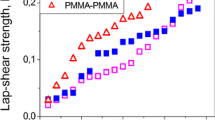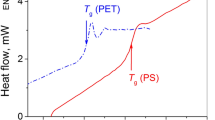Abstract
The emission of charged particles in high vacuum (at a pressure of 10−5 Pa) has been investigated during the deformation process of the monolithic bulk samples of amorphous polystyrene (PS) and poly(2,6-dimethyl-p-phenylene ether) (PPE), and of homo- and hetero-adhesive single lap-shear joints PPE–PPE and PS–PPE, respectively. The adhesive joints were formed by holding in contact the two bulk samples of PPE or the samples of PS and PPE at a small contact pressure of 0.03 MPa at the self-healing temperatures well below (by 100 K or even lower) of the PPE bulk glass transition temperature. It has been shown that the mechanoemission of charged particles has occurred at the moment of fracture (time interval < 1 ms) both of the PS and PPE bulk samples and of the PPE–PPE and PS–PPE adhesive joints and continued after the adhesive joint fracture. It has been found that, upon the adhesive joints fracture, the emission of negative ions has not been observed while electrons have been emitted. The fracture mechanisms of the bulk samples and of adhesive joints have been discussed. An equation relating the concentration of the broken chemical bonds to the intensity of the charged particles has been proposed.

Graphical abstract










Similar content being viewed by others
References
Strobl GR (2007) The Physics of Polymers. Concepts for Understanding Their Structure and Behavior3rd edn. Springer-Verlag, Berlin. https://doi.org/10.1007/978-3-540-68411-4
Boiko YM, Prud’homme RE (1997) Bonding at symmetric polymer/polymer interfaces below the glass transition temperature. Macromolecules 30:3708–3710. https://doi.org/10.1021/ma960002x
Boiko YM, Guérin G, Marikhin VA, Prud’homme RE (2001) Healing of interfaces of amorphous and semicrystalline poly(ethylene terephthalate) in the vicinity of the glass transition temperature. Polymer 42:8695–8702. https://doi.org/10.1016/S0032-3861(01)00406-2
Boiko YM (2014) On the continuity of the diffusion behaviour at amorphous polymer-polymer interfaces on both sides of the bulk glass transition temperature. Colloid Polym Sci 292:1719–1723. https://doi.org/10.1007/s00396-014-3238-4
Boiko YM (2011) Interdiffusion of polymers with glassy bulk. Colloid Polym Sci 289:1847–1854. https://doi.org/10.1007/s00396-011-2508-7
Boiko YM, Lyngaae-Jørgensen J (2004) Bonding at compatible and incompatible amorphous interfaces of polystyrene and poly(methyl methacrylate) below the glass transition temperature. J Macromol Sci Part B Phys 43:695–709. https://doi.org/10.1081/MB-120030015
Mansfield KF, Theodorou DN (1991) Molecular dynamics simulation of a glassy polymer surface. Macromolecules 24:6283–6294. https://doi.org/10.1021/ma00023a034
Kajiyama T, Tanaka K, Takahara A (1995) Depth dependence of the surface glass transition temperature of a poly(styrene-block-methyl methacrylate) diblock copolymer film on the basis of temperature-dependent X-ray photoelectron spectroscopy. Macromolecules 28:3482–3484. https://doi.org/10.1021/ma00113a059
Meyers GF, DeCoven BM, Seitz JT (1992) Is the molecular surface of polystyrene really glassy? Langmuir 8:2330–2335. https://doi.org/10.1021/la00045a042
Boiko YM (2010) Surface glass transition of amorphous miscible polymers blends. Colloid Polym Sci 288:1757–1761. https://doi.org/10.1007/s00396-010-2315-6
Boiko YM (2010) New simple sethod of measuring the surface glass transition temperature of polymers. J Polym Sci Part B Polym Phys 48:2012–2021. https://doi.org/10.1002/polb.22081
Boiko YM, Zakrevskii VA, Pakhotin VA (2014) Chain scission upon fracture of autoadhesive joints formed from glassy poly(phenylene oxide). J Adhes 90:596–606. https://doi.org/10.1080/00218464.2013.822305
Zakrevskii VA, Pakhotin VA (2010) Emission of negative and positive ions at rupture of polymers. Phys Solid State 52:1155–1161. https://doi.org/10.1134/S1063783410060077
Zakrevskii VA, Pakhotin VA (1981) Autoionization mechanism of the rupture of chemical-bonds in macromolecules. Polym Sci USSR 23:741–746. https://doi.org/10.1016/0032-3950(81)90022-8
Dickinson JT, Donaldson EE, Park MK (1981) The emission of electrons and positive ions from fracture of materials. J Mater Sci 16:2897–2908. https://doi.org/10.1007/BF00552976
Yee AF (1977) Mechanical properties of mixtures of two compatible polymers. Polym Eng Sci 17:213–219. https://doi.org/10.1002/pen.760170310
Fuller KNG, Fox PG, Field JE (1975) The temperature rise at the tip of fast-moving cracks in glassy polymers. Proc Royal Soc Lond A 341:537–557. https://doi.org/10.1098/rspa.1975.0007
Dickinson JT, Jensen LC, Langford SC, Dion RP (1994) Temperature measurements of the gaseous emission during the fracture of polystyrene: a determination of the fracture energy and fracture surface temperature. J Polym Sci Part B Polym Phys 32:779–784. https://doi.org/10.1002/polb.1994.090320419
Zarkhin LS (2006) Energetics of low-molecular-mass products of mechanical fracture of poly(methylmethacrylate). Polym Sci A 48:1086–1097. https://doi.org/10.1134/S0965545X06100105
Madorsky SL (1964) Thermal Degradation of Organic Polymers, Interscience. Wiley, New York
Mel'ker AI, Mikhailin AI, Kuznetsova TE (1980) Breaking down of an anharmonic chain of atoms. Mech Compos Mater 15:462–465. https://doi.org/10.1007/BF00605879
Sakaguchi M, Kinpara H, Hori Y, Shimada S, Kashiwabara H (1984) Ionic products from the mechanical fracture of solid polypropylene. Polymer 25:944–946. https://doi.org/10.1016/0032-3861(84)90077-6
Illenberger E, Smirnov BM (1998) Electron attachment to free and bound molecules. Physics-Uspekhi 41:651. https://doi.org/10.1070/PU1998v041n07ABEH000418
Pakhotin VA, Zakrevskii VA, Sudar NT, Apaseyev AA (2018) The emission of electrons and positive ions from fracture of materials. J Phys Math 11(2):106–118. https://doi.org/10.18721/JPM.11210
Pakhotin VA (2014) Formation of anions and cations of atomic hydrogen by cathode operation. Proceedings of 10th International Vacuum Electron Sources Conference. IEEE. ISBN: 978-1-4799-5772-9. https://doi.org/10.1109/IVESC.2014.6892052
Smirnov IV, Sud’enkov YV (2011) Crack dynamics in polymethyl methacrylate plates under quasi-static and dynamic loading. Tech Phys 56:1811–1814. https://doi.org/10.1134/S1063784211120140
Tomashevskii EE, Egorov EA, Savostin AY (1975) Thermal effects during fracture in polymers. Int J Fract 11:817–827. https://doi.org/10.1007/BF00012899
Carruth G, Ehrlich E (2002) In: Carruth G (ed) Bond Energies. Volume Library, vol 1. Tennessee, Southwestern.
Grandbois M, Beyer M, Rief M, Clausen-Schaumann H, Gaub HE (1999) How strong is a covalent bond? Science 283:1727–1730. https://doi.org/10.1126/science.283.5408.1727
Ainbund MR, Polenov BV (1981) Open-Type Secondary-Electron Multipliers and Their Applications. Energoizdat, Moscow (in Russian)
Plotnikov VG, Ovchinnikov AA (1978) The photochemical and radiation-chemical stability of molecules. Unimolecular reactions involving the abstraction of a hydrogen atom. Russ Chem Rev 47:247–264. https://doi.org/10.1070/RC1978v047n03ABEH002216
Funding
This work was supported by the Russian Foundation for Basic Research (project 18-08-00401).
Author information
Authors and Affiliations
Corresponding author
Ethics declarations
Conflicts of interest
The authors declare that they have no conflict of interest.
Additional information
Publisher’s note
Springer Nature remains neutral with regard to jurisdictional claims in published maps and institutional affiliations.
Rights and permissions
About this article
Cite this article
Boiko, Y.M., Zakrevskii, V.A., Pakhotin, V.A. et al. The deformation process of amorphous polymers and adhesive lap-shear joints formed thereof as studied by the emission of charged particles in high-vacuum technique. Colloid Polym Sci 297, 831–838 (2019). https://doi.org/10.1007/s00396-019-04505-6
Received:
Revised:
Accepted:
Published:
Issue Date:
DOI: https://doi.org/10.1007/s00396-019-04505-6




